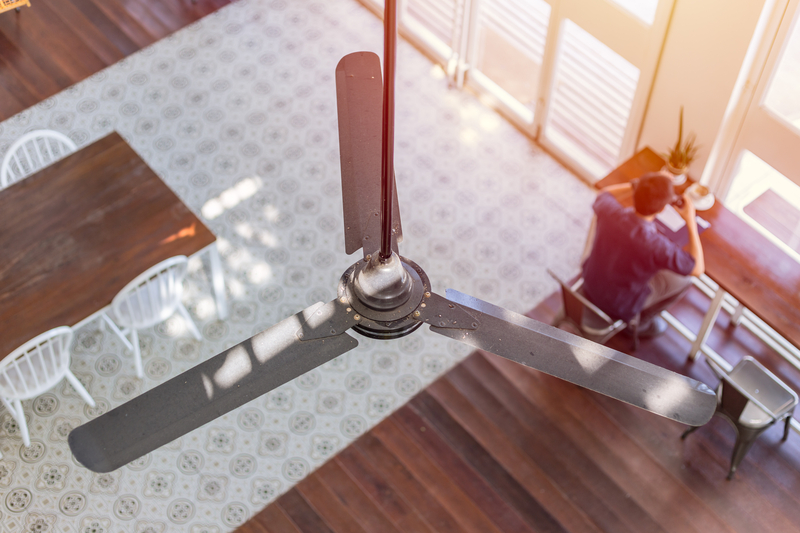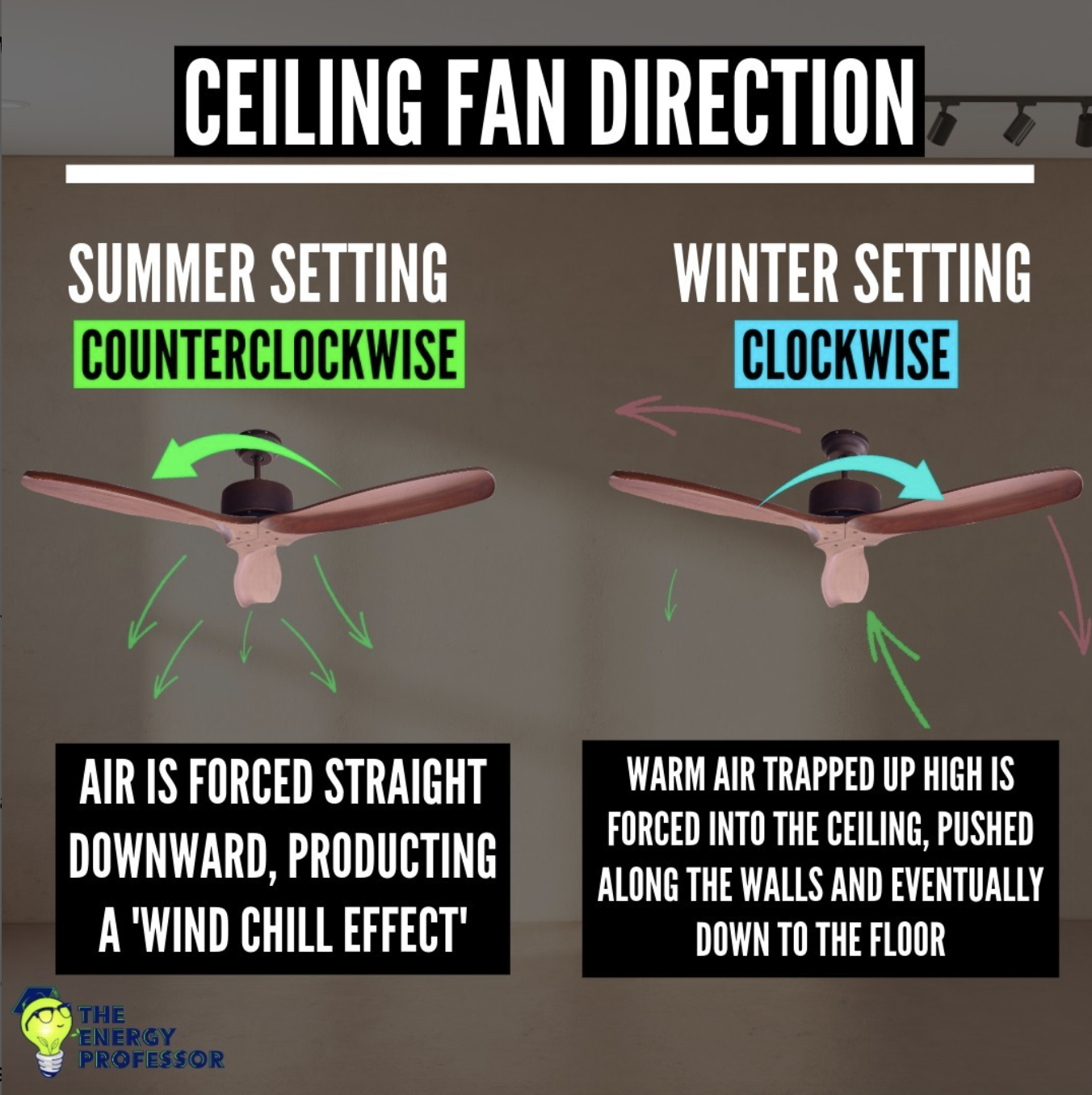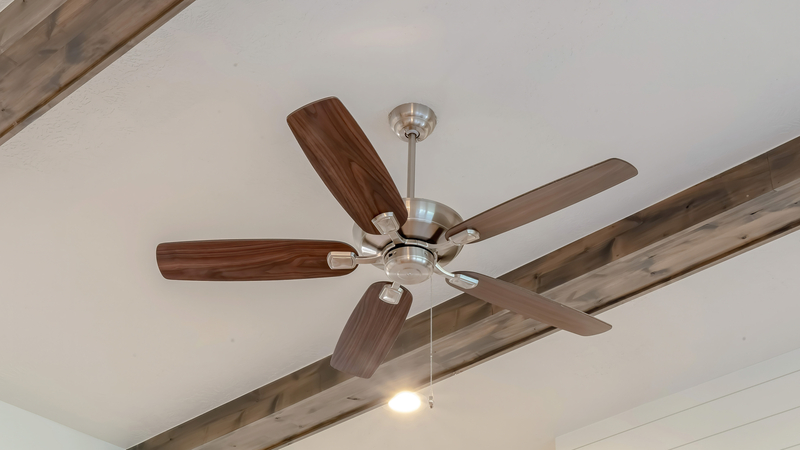This article is your complete guide to understanding the correct ceiling fan direction for the summer and winter seasons. In the summer, your fan should rotate counterclockwise. In the winter, your ceiling fan should rotate clockwise. The difference in ceiling fan rotation can affect both the temperature and how much you spend on your energy bill. We hope to help you optimize your fan settings for both summer and winter, helping you get the most out of this often-overlooked home feature!
Here at The Energy Professor, we want to give you the information you need to not only save money on your energy bill but also to become more energy efficient. We hope you find this post helpful and makes it easier for you to know more about which direction your fan should spin. Be sure to also check out our one-of-a-kind energy savings calculator!
The Energy Professor Electricity Rate Check Tool
Ceiling Fan Direction for Summer

During the hot summer months, setting your ceiling fan to rotate counterclockwise pushes cool air downward. This “wind-chill effect” makes the room feel cooler with more cold air. This fan direction for summer allows you to turn up the thermostat and save on air conditioning costs without sacrificing comfort. When a ceiling fan spins counterclockwise, airflow directly below the fan increases. Making anyone in the room feel cooler despite the actual room temperature not decreasing.
Fan Direction with Air Conditioning
When a ceiling fan is used with an air conditioner, setting your ceiling fan direction for summer counterclockwise can make a room feel up to 8 degrees cooler. This allows you to raise the thermostat setting by the same amount, which can reduce your air conditioning costs by up to 40%. It’s a simple change that enhances the efficiency of both your ceiling fan and AC unit.
Related Post: Best Cost Saving Temperature AC Setting
Ceiling Fan Direction for Winter

In winter, the ceiling fan direction should be set to clockwise at a low speed. This ceiling fan direction switch helps circulate warm air since hot air rises to the ceiling and pushes it down along the walls and back to the floor. Also known as an updraft, this clockwise rotation allows you to adjust your heating settings to lower temperatures and reduce your energy consumption.
Should I use a Fan With My Heater?
Using a ceiling fan in winter may seem counterintuitive, but it can actually assist in heating your home more effectively! When your fan is set to the right ceiling fan direction (clockwise) and used with your heating system, the fan blades distribute the warm air more evenly throughout the room. This not only increases your comfort but can also help you save on your heating costs!

Related Post: 15 Ways to Save Energy in the Winter
How to Change Your Ceiling Fan Direction

If you want to change the ceiling fan direction, it depends on the type of fan you have. Overall, most ceiling fans can change the ceiling fan direction for circulating air all year. Here’s how to adjust it for different fan types:
Pull Chain Fans
- Check the fan body or light fixture for the fan switch.
- Slide the switch in the opposite direction.
- Turn the fan back on and replace any lights or glass pieces you had to remove to get to the fan switch.
Most traditional ceiling fans with a pull chain have a small switch on the motor housing that controls the direction. Simply switch off the fan, wait for the blades to stop completely, then flip the switch to reverse the rotation.
Remote Start Fan
- Press and hold the fan button on the handheld remote control.
For ceiling fans operated by a remote, there’s usually a button labeled for reversing the fan direction. You can change the direction with a simple press, ensuring the fan is off before making the adjustment to prevent damage to the motor.
Smart Ceiling Fan
- Toggle the ceiling fan direction option in the fan’s app or use a voice command to reverse your ceiling fan on your smart device.
Smart ceiling fans can often be controlled through a smartphone app or a voice-activated home system. These systems typically include an option to reverse the fan direction. Consult your specific model’s guide for detailed instructions on making adjustments via its app.
Related Post: 8 Tips to Lower Your Energy Bill
When Should I Change the Direction of My Ceiling Fan

The best time to change your ceiling fan direction is during seasonal transitions. Switch to a counterclockwise direction in the early summer when you first start to use your air conditioning. In the winter, make the switch to clockwise rotation when you turn on your heating system for the first time. Regularly adjusting your ceiling fan settings not only maximizes comfort but also enhances energy efficiency throughout the year!
Related Post: Does a Ceiling Fan use a lot of Electricity?
Ceiling Fan Direction FAQ

Q: How does changing the ceiling fan direction save energy?
A: Changing the ceiling fan direction helps maximize the effectiveness of heating and cooling systems. In summer, a counterclockwise rotation creates a cooling effect, allowing you to set the thermostat higher and use less air conditioning. In winter, a clockwise rotation redistributes warm air that rises to the ceiling, enabling you to lower the thermostat and reduce heating costs.
Q: Can all ceiling fans change direction?
A: Most modern ceiling fans are designed to change direction. Look for a small switch on the body of the fan or options on the remote control or smart fan app that allow you to reverse the blade rotation.
Q: What if my ceiling fan doesn’t have a visible switch to change direction?
A: If your fan doesn’t have a visible switch, it may be controlled remotely. Check your remote control for a reverse button. If there isn’t one, consult the user manual or manufacturer’s website for guidance, as some newer models integrate direction control into a smartphone app or home automation system.
Do you Need Cheaper Electricity?
If you’ve taken the time to understand the information on your bill and discovered you’re paying more than you’d like for your electricity, have you looked around for a cheaper deal? The Energy Professor has a wealth of information on ways to save on your utilities, including details of top deals that could significantly reduce your monthly or quarterly electricity bills.
We hope you found this article helpful! If you are looking for ways to increase energy efficiency and sustainability in your home, be sure to take a look at all of the latest renewable energy options in your area. The Energy Professor helps residential and small business owners find qualified energy suppliers in New York, New Jersey, Pennsylvania, Texas, Ohio, Maryland, Illinois, and Massachusetts.


